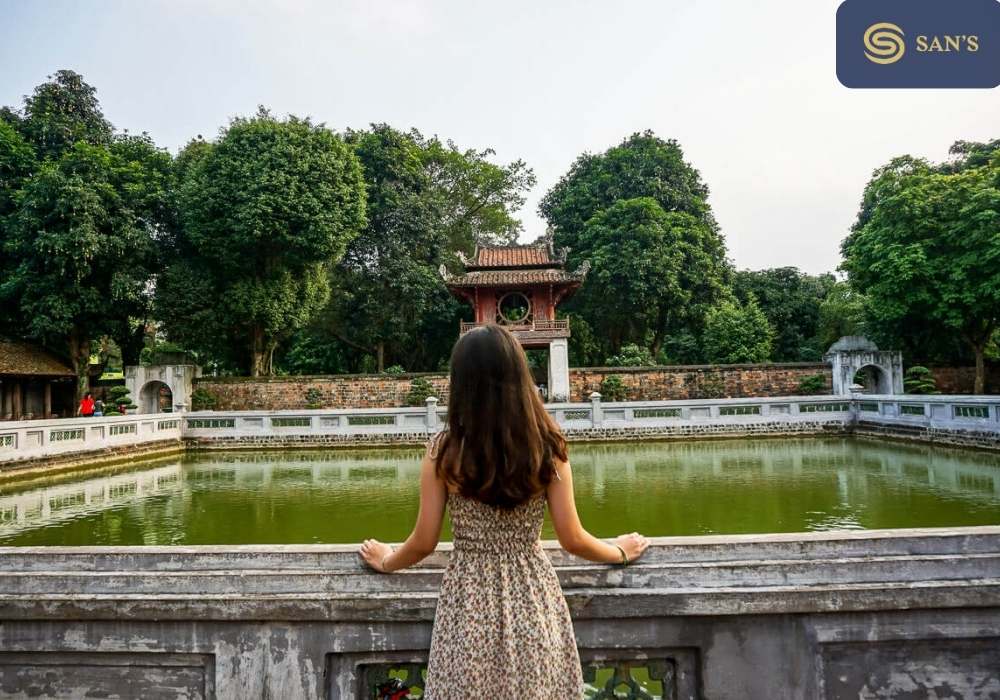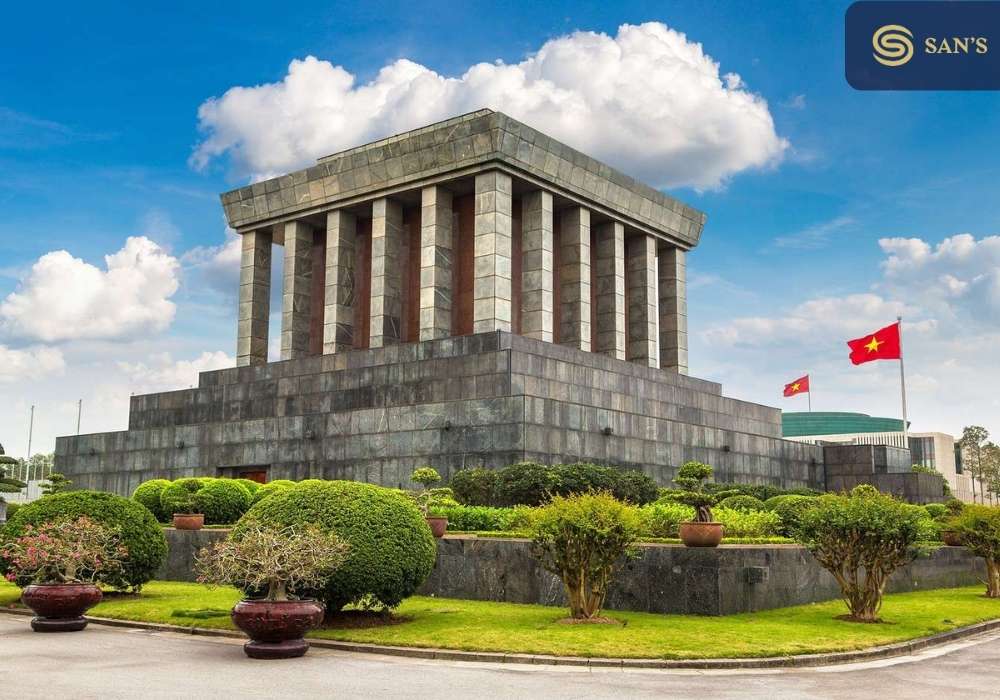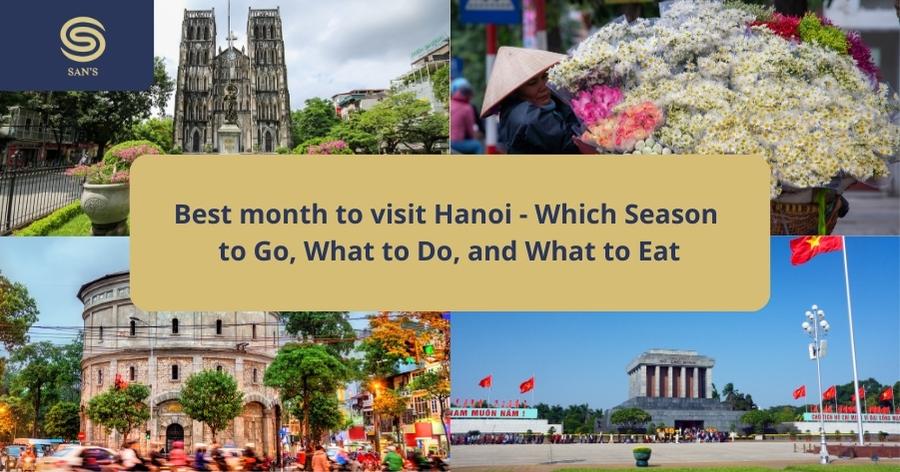As we tread the paths where history and culture converge, we uncover the gems that make Hanoi a city of timeless allure. Every alley, monument, and edifice tells a story, inviting visitors to step into the pages of a living history book. In this narrative, we spotlight the top 5 historical and cultural Hanoi things to see.
These landmarks, each unique, invite you to traverse time, offering a deeply immersive experience where the echoes of the past resonate amidst the hum of a modern, bustling city. Join us as we unfold the layers of time, unveiling the historical and cultural jewels that epitomize Hanoi’s soul.
The Temple of Literature
A visit to Hanoi is incomplete without witnessing the architectural spectacle of The Temple of Literature. It’s a prominent feature on the list of Hanoi things to see. Nestled in the heart of the city, this masterpiece showcases aesthetic intricacies and ancient architecture, offering visitors a visual narrative of Vietnam’s historical artistry.

Each corner of the temple is an eloquent testament to a bygone era of architectural magnificence, making it a vital stop for those eager to explore Hanoi things to see.
The Temple of Literature isn’t just an architectural gem; it’s a living embodiment of Vietnam’s deep-rooted reverence for education and learning. This iconic temple transcends time, echoing the scholarly pursuits and intellectual achievements of ancient Vietnamese society. For any traveler curating their list of Hanoi things to see, this temple offers an enriching dive into a world where academia and spirituality intertwine seamlessly.

As one of the quintessential Hanoi things to see, the modern visitor is welcomed into a space that breathes historical and cultural richness. Tips for prospective visitors include exploring the temple’s five meticulously designed courtyards, each offering a distinct experience imbued with historical significance.
The serenity that envelops this space offers a respite from the city’s hustle, marking the Temple of Literature as a must-experience historical and cultural oasis amongst Hanoi things to see.
Hoa Lo Prison Museum
Hoa Lo Prison Museum, one of the most poignant Hanoi things to see, stands as a stark reminder of Vietnam’s turbulent past. This site, once dubbed the “Hanoi Hilton” by American POWs, unearths the haunting stories and events that are intricately woven into the fabric of Vietnam’s history.

Visitors walk through corridors echoing with narratives of resilience, defiance, and survival. Each cell and exhibit narrates tales of incarceration, offering an unfiltered glimpse into periods of colonial resistance and the Vietnam War, solidifying its place among essential Hanoi things to see.
The journey of Hoa Lo Prison from a site of incarceration to a revered museum is a narrative of change and remembrance. It’s more than a transformation of purpose; it’s a reclamation of narratives, a space where stories of endurance and humanity are brought to the fore.
In the heart of a city renowned for its vibrance and growth, this museum serves as a poignant reminder of the indomitable spirit of the Vietnamese people. Its preservation and transformation underscore its indispensable presence in the array of historical and cultural Hanoi things to see.

As one navigates through the historical richness of Hanoi, a visit to Hoa Lo Prison Museum offers an experience of depth and reflection. Essentials for a comprehensive visit include guided tours to gain insightful context, exploring the detailed exhibits, and taking moments to reflect on the powerful narratives displayed.
The prison’s proximity to Hanoi’s central district makes it easily accessible for those keen to delve into the more somber and reflective aspects of Hanoi things to see. Each visit promises an enriching journey through chapters of history that define the resilient spirit of Vietnam.
Ho Chi Minh Mausoleum
In the panorama of Hanoi things to see, the Ho Chi Minh Mausoleum isn’t just a monument; it’s a sacred space that houses the final resting place of Ho Chi Minh, Vietnam’s revered leader. Nestled in the center of Ba Dinh Square, the site where he declared Vietnam’s independence in 1945, the mausoleum is a profound journey through the life and contributions of the man affectionately known as ‘Uncle Ho’.

Visitors from around the globe come to pay homage, making it a pivotal point of interest among the historical and cultural Hanoi things to see.
Exploring the Ho Chi Minh Mausoleum offers an intimate insight into the life and legacy of a leader who shaped Vietnam’s contemporary narrative. Visitors should prepare for an experience marked by solemnity and respect.
The stately architecture, the changing of the guards, and the serene atmosphere combine to create a memorable encounter. Within the silence and reverence lies an opportunity to reflect upon the indelible marks left by Ho Chi Minh on Vietnam’s history, an essential experience for those exploring Hanoi things to see.
Given the mausoleum’s significance, visitors are encouraged to approach with decorum. Guidelines include dressing modestly, maintaining silence, and avoiding photography within the mausoleum. Such protocols aren’t just regulations but gestures of respect towards a national icon who resides in the collective memory of the Vietnamese people.

These respectful gestures enrich the experience, making the visit to the Ho Chi Minh Mausoleum a reflective sojourn amidst the exploration of Hanoi things to see.
Incorporating this iconic site into your itinerary promises an opportunity to engage with Vietnam’s history and culture on a profound level, and experience one of the most significant Hanoi things to see.
The Imperial Citadel of Thang Long
Amidst the vibrant landscape of Hanoi things to see, the Imperial Citadel of Thang Long stands as a silent, yet eloquent testament to the city’s enduring legacy. Each stone and structure within this ancient fortress narrates tales of emperors, invasions, and resilience. The ruins, though silent, echo the tumultuous and triumphant epochs of Vietnam’s history.
Visitors embarking on a journey to explore these ancient remnants are transported through time, offering a tactile connection to the stories and spirits that permeate these historic walls.

Earning its esteemed position amongst the globally recognized Hanoi things to see, the Imperial Citadel of Thang Long proudly stands as a UNESCO World Heritage Site. This acknowledgment isn’t just a testament to its architectural grandeur but underscores its historical and cultural significance.
Each courtyard and relic within the citadel is a page from the annals of history, offering insights into the sociopolitical and cultural dynamics of ancient Vietnam. This global recognition elevates the citadel from a national treasure to a global spectacle, accentuating its prominence among Hanoi things to see.
Navigating the echoing halls and silent courtyards of the Imperial Citadel of Thang Long requires a harmonious blend of curiosity and reverence. For the best experience, visitors are encouraged to opt for guided tours to glean in-depth insights into the citadel’s historical context.

Morning visits are recommended to avoid the afternoon rush and to explore the site in the soft, illuminating embrace of natural light. Comfortable footwear is a must, given the extensive grounds waiting to unveil the hidden tales of Vietnam’s royal past, making the visit a remarkable chapter in the narrative of Hanoi things to see.
In the ceaseless rhythm of Hanoi’s modern life, the Imperial Citadel of Thang Long stands as a sanctuary where the echoes of the past are not just heard but felt, offering a profound, sensory journey into the annals of Vietnam’s history. Each visit promises not just a tour but a narrative, making the citadel a gem among the historical and cultural Hanoi things to see.
The Hanoi Opera House
In the eclectic mix of Hanoi things to see, the Hanoi Opera House stands distinguished, not just as an architectural masterpiece but as a cultural epicenter of the city. With its ornate designs, grandeur, and intricate detailing that mirrors French colonial architecture, it’s a vivid remnant of Hanoi’s historical tapestry.

Beyond its physical allure, the Opera House is a vibrant space where art, culture, and history converge, echoing the city’s rich cultural heritage and evolving artistic landscape.
The curtains of the Hanoi Opera House may have witnessed the changing tides of history, but they still rise to the eclectic beats of modern performances. Amidst the classic ambiance, contemporary arts come to life, showcasing a blend of traditional and modern artistic expressions.

Ballet, opera, local musicals, and international performances grace the stage, making it a dynamic spot in the repertoire of Hanoi things to see. The enduring elegance of the architecture, paired with the vibrancy of modern-day shows, encapsulates the harmonious blend of Hanoi’s rich past and pulsating present.
Stepping into the Hanoi Opera House is akin to traversing the pathways of artistic excellence. For those looking to immerse themselves in this iconic cultural experience among the myriad of Hanoi things to see, understanding the booking nuances is key.
The Opera House’s official website or authorized ticket vendors provide detailed schedules of upcoming performances, ticket availability, and seating arrangements. Early bookings are encouraged for the best seats, offering an unobstructed experience of artistic splendor encapsulated within one of Hanoi’s most esteemed cultural landmarks.
FAQs
Q1: What are the operating hours of the Temple of Literature?
A: The Temple of Literature is open from 8:00 AM to 6:00 PM daily. Visitors looking to explore one of the most prominent Hanoi things to see are advised to check the official website or contact the facility directly for any changes in operating hours during holidays or special events.
Q2: Are there guided tours available at the Hoa Lo Prison Museum?
A: Yes, guided tours are available at Hoa Lo Prison Museum. English-speaking guides offer in-depth insights into the haunting history and transformation of this iconic site, enhancing the visitor experience among the vast offering of Hanoi things to see.
Q3: What is the dress code for visiting the Ho Chi Minh Mausoleum?
A: Visitors are required to dress modestly, covering shoulders and knees, as a sign of respect when visiting the Ho Chi Minh Mausoleum. It’s a place of national reverence, and decorum is an integral part of the experience.
Q4: How can I get tickets to performances at the Hanoi Opera House?
A: Tickets can be purchased online via the Hanoi Opera House’s official website, authorized ticket vendors, or at the box office. It’s advisable to book in advance to ensure availability, especially for popular shows.
Q5: Is photography allowed inside the Imperial Citadel of Thang Long?
A: Photography is generally allowed in the outdoor areas of the Imperial Citadel of Thang Long, but restrictions may apply in certain indoor exhibitions or sensitive areas. Always look for signage or ask staff for guidelines to respect the site’s rules.
Q6: Are these historical and cultural sites wheelchair accessible?
A: Accessibility varies by location. It’s recommended for visitors with mobility challenges to check with each site directly before visiting to ensure a comfortable and enjoyable experience while exploring Hanoi things to see.
Q7: Can I purchase souvenirs at these historical and cultural sites in Hanoi?
A: Many of these sites, like the Temple of Literature and Hoa Lo Prison Museum, have gift shops where visitors can purchase souvenirs. These shops often offer a range of items, including books, postcards, and art, reflecting the historical and cultural essence of the sites.





